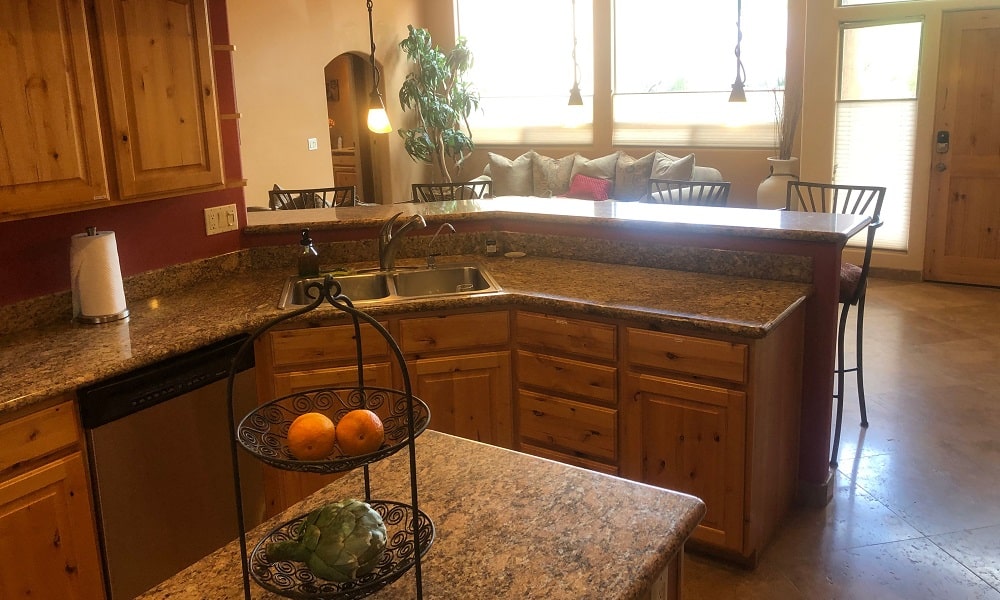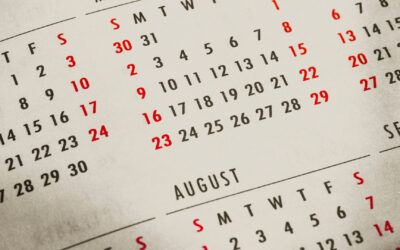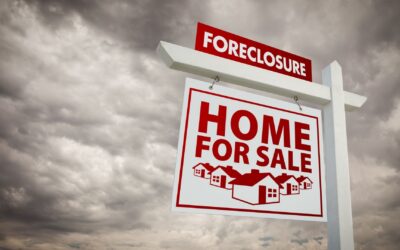BRRRR means “Buy, Rehab, Rent, Refinance, Repeat,” and is a step-by-step method used by investors who wish to build passive income over time. Each one of the steps in the BRRRR method is implemented in order. This BRRRR method of real estate investing lends itself to taking advantage of good deals as they come along, while also returning the invested cash to the investor so that the same initial investment can be used to repeat the process over and over while building a portfolio.
Here is a recent video where I explain the BRRRR method in reference to our application of it to Short-Term Rentals. The video is set at a Vacation Rental we have in Sedona, AZ, and pictures from that property are used throughout this article.
BRRRR – Each of the Steps Explained
Entire books have been written about each of the steps outlined below. However, we will provide you with the key steps and ideas that you can start putting into use right away. The BRRRR method is great not only for seasoned pros but also for investors that are just starting out. However, as with any real estate investment, it is essential to perform your due diligence before buying to ensure you are getting a property that can be a good income-producer (even if it isn’t right now).
If you have questions or would like any guidance, it’s always a great idea to find and talk with an expert in the field. Look for someone who has been there and done that, to provide you with those invaluable tips to ensure success and maximize profitability. Having said all that, let’s get started!
Buy (BRRRR)
It all starts with identifying a good property to buy. This is the foundation of the entire BRRRR method. What makes a property a good purchase is not always obvious. A nice clean property that is fully occupied with paying tenants sounds like a great start, but not if the purchase price is so high that it won’t allow you to generate a good return. Often times, that run-down property that has more squatters than paying tenants, can be the better purchase, simply because you should be able to negotiate a nice low price for it. So consider all avenues, but know that real estate can be a tough business, especially for beginners. The field is littered with land mines that can destroy your returns if you’re not careful.
If you are new to real estate investing, in order to get this step right, we recommend choosing one or both of the following:
- Do a good amount of detailed research before you dive in so you understand the risks and so you’re on top of all the pros and cons of real estate investing.
- Find an expert who has shown consistent success over at least several years of buying and adding value to investment properties.
Even experienced investors will want to do their reasonable due diligence before purchasing the property. Look at other comparable properties, and estimate rehab costs and market rents. Yes, I know that Rehab and Rent are the next steps of this technique, but you should incorporate these parts of them in the Buy step, to run your numbers before you make the purchase commitment. You won’t actually start on the rehab before you select and buy the property, but the scope of work and the estimated rehab amount needed become important parts of your due diligence before you make the buy. “Put yourself in a position to succeed.”
Rehab (BRRRR)
This step provides the greatest opportunity to forcibly increase the value of your property (“force appreciation”). So you’ll want to be mindful of those improvements that will increase the market rents that you can achieve, while not making the property so nice that you’ve exceeded the ceiling of what tenants will pay for in that area.
Hopefully, you prepared an estimation of the rehab costs, in the first step above. If so, that’s a great place to start. If not, don’t wait any longer to make a detailed list of what you need to fix or improve in order for the property to be in good rentable condition. Note that this often is different and less extensive than if you were fixing it up to flip it on the retail market. In many cases, Formica countertops are just fine for rentals, rather than incurring the extra expense for granite or quartz.
Now that you have your detailed list of items needing to be done, you’ll need to assign costs to each item. Replacing a toilet and sink vanity in the powder room might be $750 in materials and $100 in labor. Ideally, you have chosen a general contractor to do the work, and he or she will be able to help you with the detailed bid, consisting of cost estimates for each item or area. When possible, get several quotes for items that are easier to sub-contract out, such as flooring, cabinets, and countertops. There can be large differences in price between one contractor and another. I often prefer to have one primary contractor on the job, but we will coordinate specialty trades based on whether his HVAC technician, or one I know, will be a better fit for the project, based on expertise, pricing, and availability.
Having a scheduled game plan that makes sense is always a good idea before actually starting your rehab. For instance, you don’t want to replace the flooring before repairing the walls or ceilings. Take some time to consider the property and what needs to be done, in what order. Typically we start with demolition (the only line item I’m good at 🙂 ) and then major systems such as roof, electrical, HVAC and plumbing. The cosmetic items, such as paint or new lighting fixtures, should come last. Your contractor should be helpful here. I’ve seen different contractors have decidedly different ways of going about getting the various elements of the project done. Focus on staying on time and on budget.
If you don’t have a contractor or crew lined up yet, ask a local real estate investor for a referral. Or, if they are experienced with rehabs, you can ask them to come with you to the project. Consider buying them lunch and picking their brain about renovating properties. Then meet at the project and ask them what they would do, and not do, to the property, given the estimated market rents you are trying to achieve. The answer will differ if you are shooting towards the lower end of the market or the higher end.
I use a spreadsheet to capture my budget, by line item, as well as my actual costs. It is imperative to know how you are doing, against your budget, throughout the process. If you have an unexpected overage in one area, you may look to save a little on other items, to ensure that your overall rehab cost does not balloon. I also use the same spreadsheet as a checklist of sorts, as I am walking the property (either in person or virtually via FaceTime) every few days with the contractor. If the numbers and timelines are important to you, then make sure your contractor knows it. Be organized and stick to the budget wherever possible, as you force appreciation (push the value up) on your property.

Rent (BRRRR)
The leases that you create in this step will shape the cash flow and value of your asset when it comes time to refinance it in the next step. Think rental rates, security deposits, lease terms, and qualification of the tenants. Most investors rent the property to long-term tenants, which usually involves a 6 – 24 month lease for residential properties, and could be 12 – 60 months or longer for office or retail properties.
There is, however, another way. Short-term rentals, which are typically measured in days or weeks, rather than months, can be another way to rent out your residential property. You will want to have your rental strategy defined up front, and certainly before you start rehabbing the property, as leasing it as a vacation rental (think AirBnB and VRBO) may well require a different rehab scope of work, when compared to a long-term rental. Plus, you will need to furnish the property, right down to pots/pans and kitchen utensils.
**Note: In next week’s article, we will be expanding on this technique and offering advanced tips on how to build a formidable portfolio in just five years.
Regardless of whether you decide to go with short-term or long-term leases, you will want to decide whether being a landlord is for you. The choice is whether to manage it yourself or hire a property management company. If you are organized, don’t mind preparing paperwork, and are willing to educate yourself on the landlord-tenant laws in the state(s) that you’re in, then you may want to self-manage your properties. I found that I could manage up to 20-25 houses/units before the time requirements became such that I felt the opportunity cost was outweighing the management fees I was saving.
Here are a few tips to consider, whether you decide to self-manage the lease-up and rental process, or hire a management company:
- Advertising is key to finding a large pool of potential investors – use signage at the property, social media, Craigslist, your network of investor & realtor friends, etc.
- Make sure that tenants are qualified, as not all tenants will be good tenants. Check backgrounds and call references. One bad tenant can create massive headaches and potential losses, particularly if they damage the property on the way out.
- If you have multiple units to lease up all at once (an 8-plex for instance), think twice about setting all of them up with 12-month leases. While that seems easy and uniform, it increases the likelihood that you will have multiple vacancies at the end of that 12 months. A better strategy may be to spread the lease terms out so that they come due at different times. That way, you can address them as they happen, either vacancies or renewals, without as much risk of having 5 or 6 of your 8 units becoming vacant (and non-paying) at once.
Refinance (BRRRR)
As we mentioned earlier, in the Buy section, often the best candidate for your buy and hold portfolio is a property that is in rough shape and underperforming today. That’s because you can typically get the best deal on a tired property that may need significant repairs, is vacant, or is pulling in below-market rents. Even if you can negotiate enough time to buy this property with lower-interest, conventional financing, many times the condition of the property won’t qualify for such financing. So you may use all cash or get a private/hard money loan to help with the purchase.
So while you typically won’t get handed a loan with an excellent interest rate on your purchase, once you’ve fixed up the property and placed rent-paying tenants, the story changes. By refinancing the deal at this juncture, it is entirely possible for you to get back 100% of the money you’ve invested up to this point.
Here’s an example:
Let’s say you have $60,000 of cash to invest and kick-start your cash flow portfolio. You find a good Buy/Hold deal in your local market, that’s selling for $100,000, but needs $30,000 of rehab, and the carrying costs (property taxes, utilities, insurance) needed until the units are rented out is another $5,000. Once the property is improved & rented, the appraised value will be ~$200,000. So it will cost you $135,000, but it will be worth $200,000 if/when you can execute the deal by forcing appreciation into the property.
To get the deal, you get a private/hard money loan at 80% of your purchase price, or $80,000. You pay the remaining $20,000 from your cash, as a down payment, as well as the rehab ($30,000) and carrying costs ($5,000). That leaves you with $5,000 leftover, from your $60,000, to service the debt on your new loan until the rents roll in, and for cushion/reserve.
After the property has been improved and tenanted, you can then refinance it with conventional financing, typically at 70 – 75% of the appraised value of $200,000. 70% of $200,000 is $140,000, and even after loan & escrow costs (say $5,000) to close on the refinancing transaction, you will have paid off the private/hard money loan of $80,000, and received your $55-60,000 initial investment back, plus you now have $60,000 in equity ($200,000 appraised value minus the $140,000 new loan), as well as the cash flow stream that it will generate!
There are two primary types of refinance loans for rental properties. One is a Rate and Term ReFi, where you are keeping the same principal amount as the underlying loan, just with better (lower) interest rates and better (longer) term. But the ReFi program that you want for this example is called a Cash Out ReFi so that you not only pay off the $80,000 private/hard money loan but also pull out most or all of your cash that you invested to purchase and force appreciation into the property. Typically the LTV (loan to value) percentage from lenders will be ~70% on Cash Out ReFis, and about 5 points higher, or ~75% on Rate and Term ReFis.
Now that you have your pool of money back, you’re ready for the final step.
Repeat (BRRRR)
Thanks to your ability to find a smart investment property, rehab it to optimize forced appreciation, rent it out, and refinance the asset, you now have the resources to do it all over again. And the best part is that you have not only generated a monthly cash flow, but you’ve also built up equity in the property — $60,000 of it in the above example.
It’s time to take your experience and go find another smart property to purchase. Congratulations! You’re on your way to achieving true wealth and financial freedom!
Conclusion
The BRRRR method of real estate investing is a great model to follow for creating financial freedom and wealth. It’s a sequential model, where each step is done in order, although there can be some overlapping of the steps as you go. The end result, if performed well, is securing one cash-flowing asset after another, while pulling out most/all of your seed capital each time.
To summarize, here is how I view the importance of each of these vital steps when distilled down to just one sentence for each:
Buy – a smart buy doesn’t guarantee your profits at the end of the rainbow, but a bad buy can certainly lock in losses, so “put yourself in a position to succeed.”
Rehab – here you get to force the most Appreciation into your property, by choosing the right elements to physically improve upon, in order to optimize your rental income.
Rent – the rents, and how you structure your leases, will define your cash flow and further shape the value of your project.
Refinance – if the previous steps were executed well, this step allows you to both pull out most/all of your initial cash investment, and drop the asset into long-term, low-interest financing to help generate cash flow.
Repeat – we now take our learnings and go back and repeat the steps with another asset, using the efficiencies and expertise we gained to replicate and build upon our cash flow portfolio.
The information we’ve presented here is a high-level, broad overview of the general concept of the method. If you want to get started with real estate investing yourself and this strategy sounds appealing to you, reach out to us and we’ll help you figure out exactly how to execute it, all the way down to the finest detail.
**Note: In next week’s article, we will be expanding on this technique and offering advanced tips on how to build a kick-butt portfolio in just five years.






